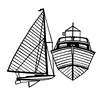|
The following article appeared in the Cedar Chest, the Toms River High School publication, by Milton Endres, of Seaside Heights, one century ago, and reprinted by the New Jersey Courier, in the February 23rd, 1923 edition. Fishing is one of the most important industries of New Jersey, mainly because of the long, sandy coast. This industry includes, besides the numerous ocean fisheries, many oyster and clam farms. The ordinary ocean fishery employs from twenty to thirty men who are usually natives of northwestern Europe. The fisheries, or pounds, as they are commonly called, consist of a bunk-house and kitchen combined, an ice house, and a shipping platform on the shore. They have one or two large sea skiffs with one hundred horsepower engines. The nets, which are three to five in number, are large pockets thirty feet square with a conical hole in the shore side. From the middle a straight net is run shoreward to intercept the fish, which follow the net and enter the pocket, from which few escape. These nets are fastened to poles about a mile from shore in 50 or 60 feet of water. The poles are not brought in during the winter, although some wash away in severe storms. The fishing season begins in the spring, as soon as the danger from storms is over and the fish begin to “run” north, which is usually March or April. The nets are tarred in order to withstand the salt water. For this, large pots about six feet in diameter, with a fireplace beneath, are used. When the season is on, the work becomes more regular. The boats leave at 4 or 5 in the morning to lift the nets. There is a rope from the shore to a pole about a quarter of a mile out, which is used to steady the boat until the engine is started. After the nets are reached, the boat is stopped at the side of a pocket. It is lifted by beginning on one side and tumbling the fish together. The fish are then scooped into the boat with large hand nets, where they are assorted roughly and small or undesirable fish are thrown overboard. After lifting all the nets, the boat returns to shore and is landed by a team of horses. Upon landing, the fish are sorted according to size and kind.
The quantity of a catch varies from a few barrels to two and three hundred barrels. It usually includes flounder, weakfish, butterfish, sea bass and bonito. Some species, such as weakfish, codfish and whiting, are gutted to prevent decay. They are then taken to the shipping platform, where they are packed with ice in barrels, after which they are shipped to the large fish markets. The rest of the day is spent in cleaning the boats, repairing the nets, and doing odd jobs around the place. The height of the season comes in July and August, after which it steadily declines, and ends during November when the fish stop “running” or go to south for the winter. In the winter, most of the men follow the fish south, but a few remain to refill the ice house. If there is plenty of natural ice nearby, that is used. Otherwise, artificial ice is bought. The fishermen are usually large, heavily built men and are as a whole, generous and congenial, especially to children. They are also fearless and go to sea in very rough weather. Comments are closed.
|
NEWSArchives
May 2024
Categories |
OPEN TUES/THURS/SAT 10 to 2
Barnegat Bay Maritime MuseumVertical Divider
|
Upcoming EventsVertical Divider
|
|
© Barnegat Bay Maritime Museum. All rights reserved.







 RSS Feed
RSS Feed
